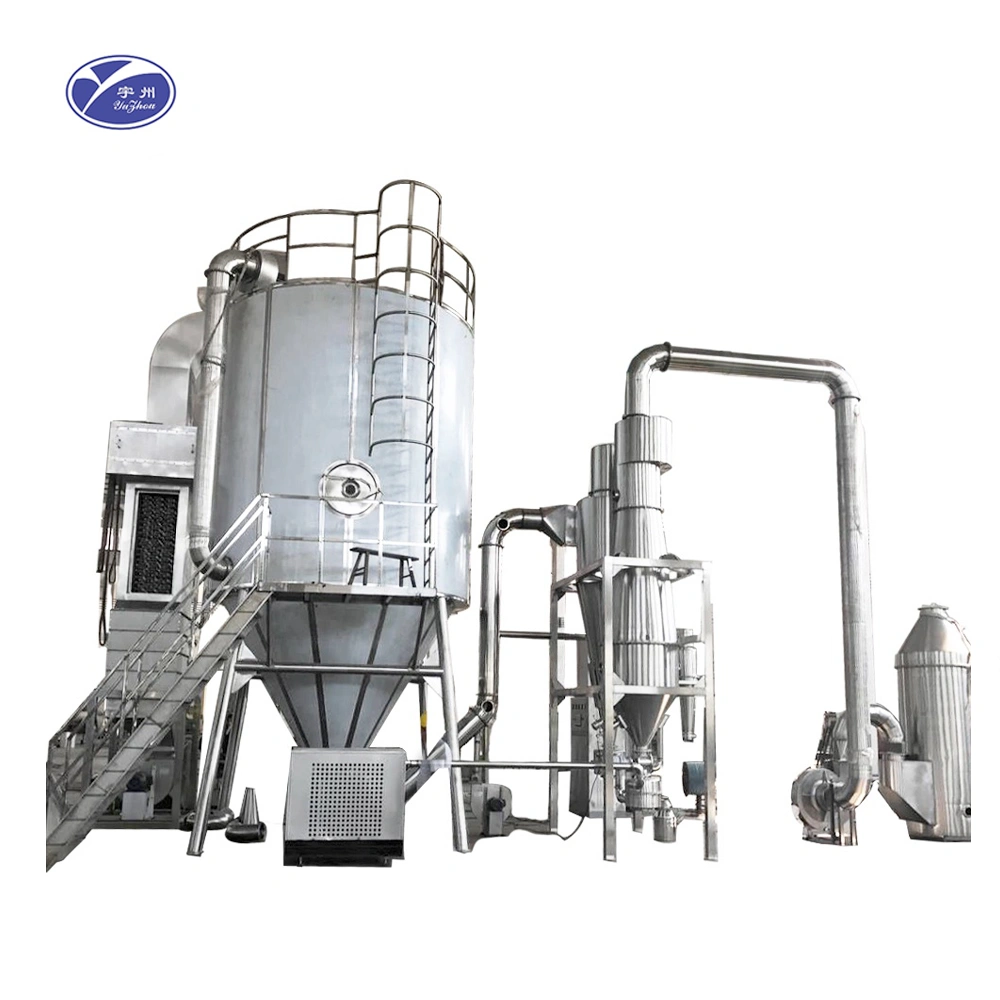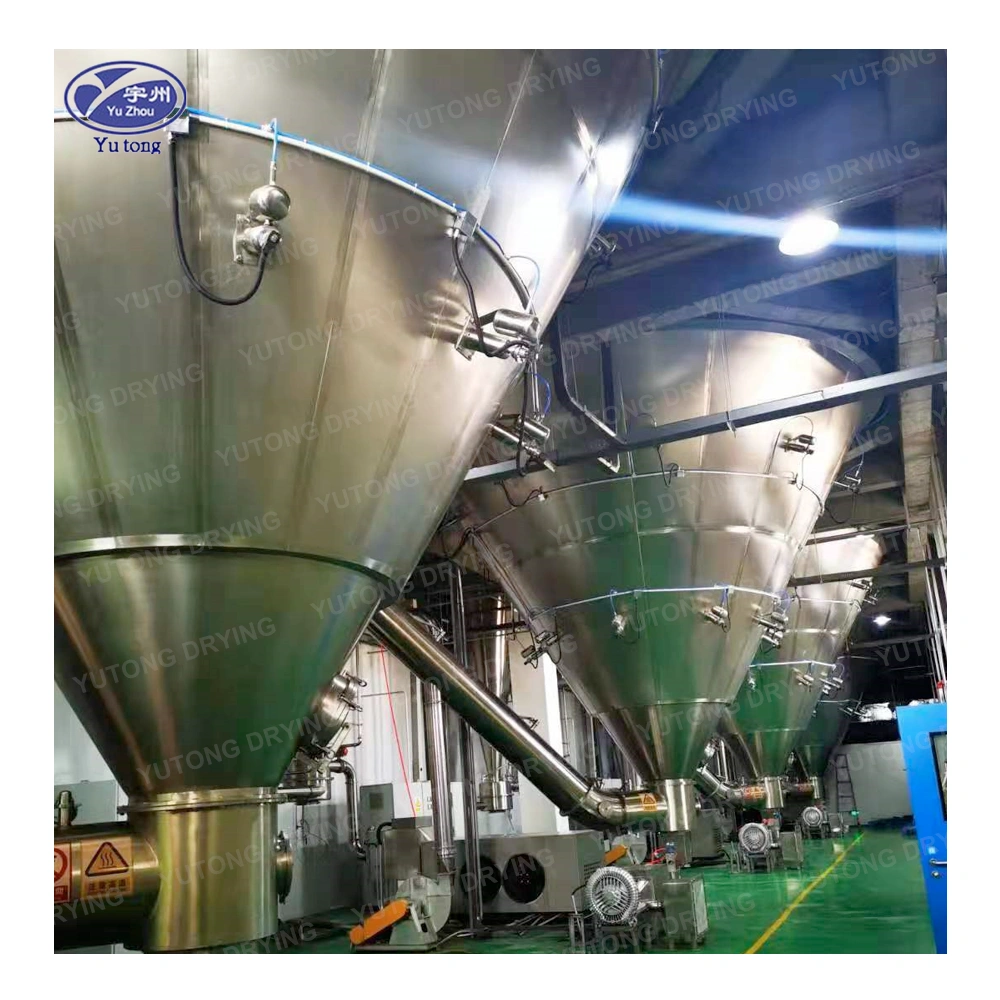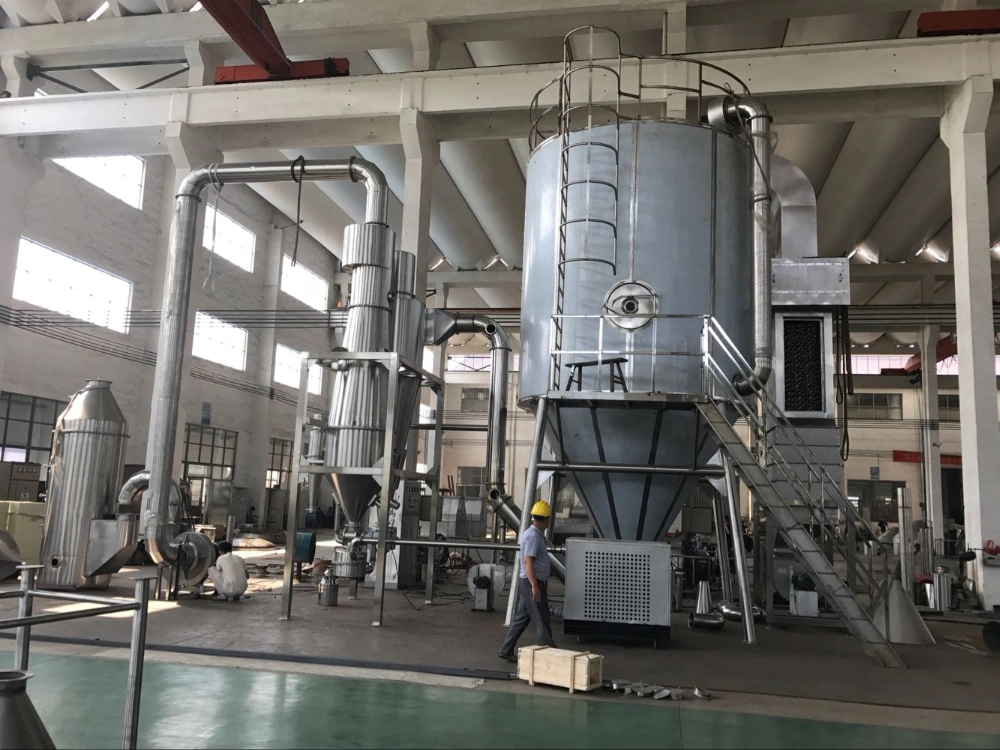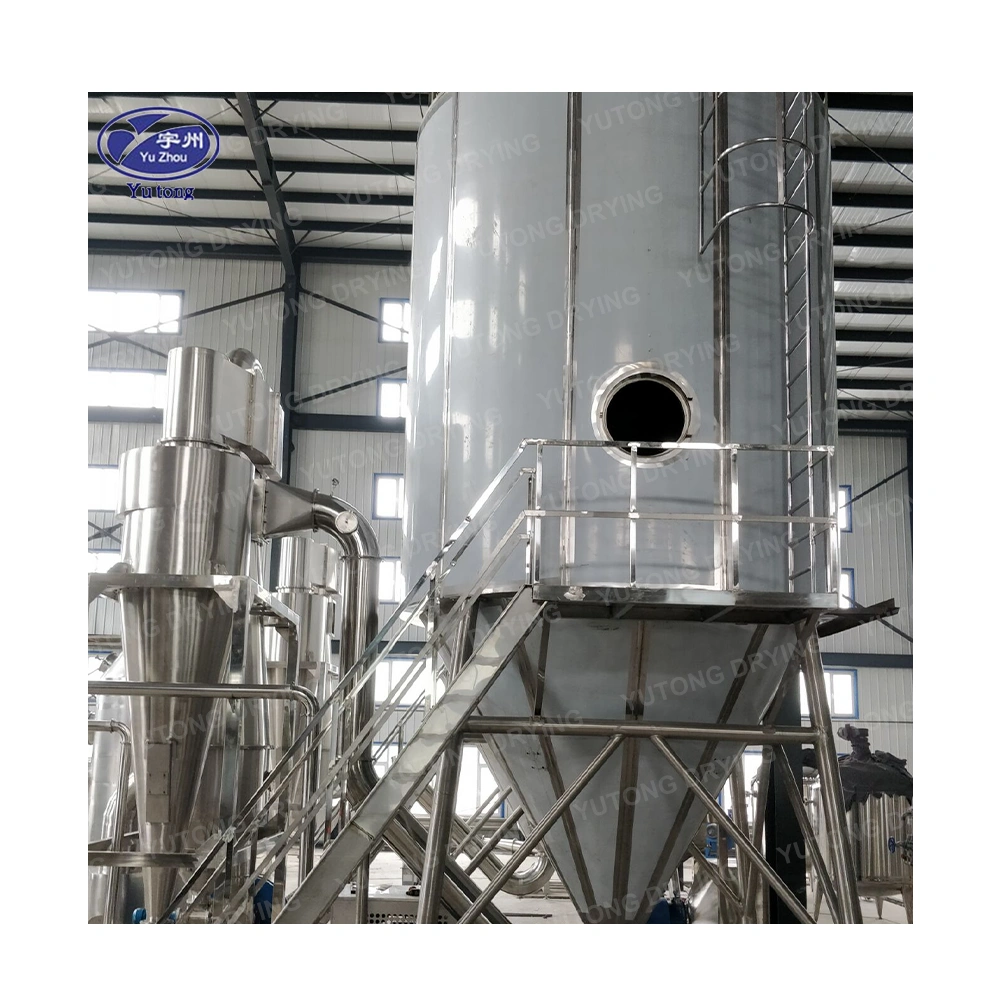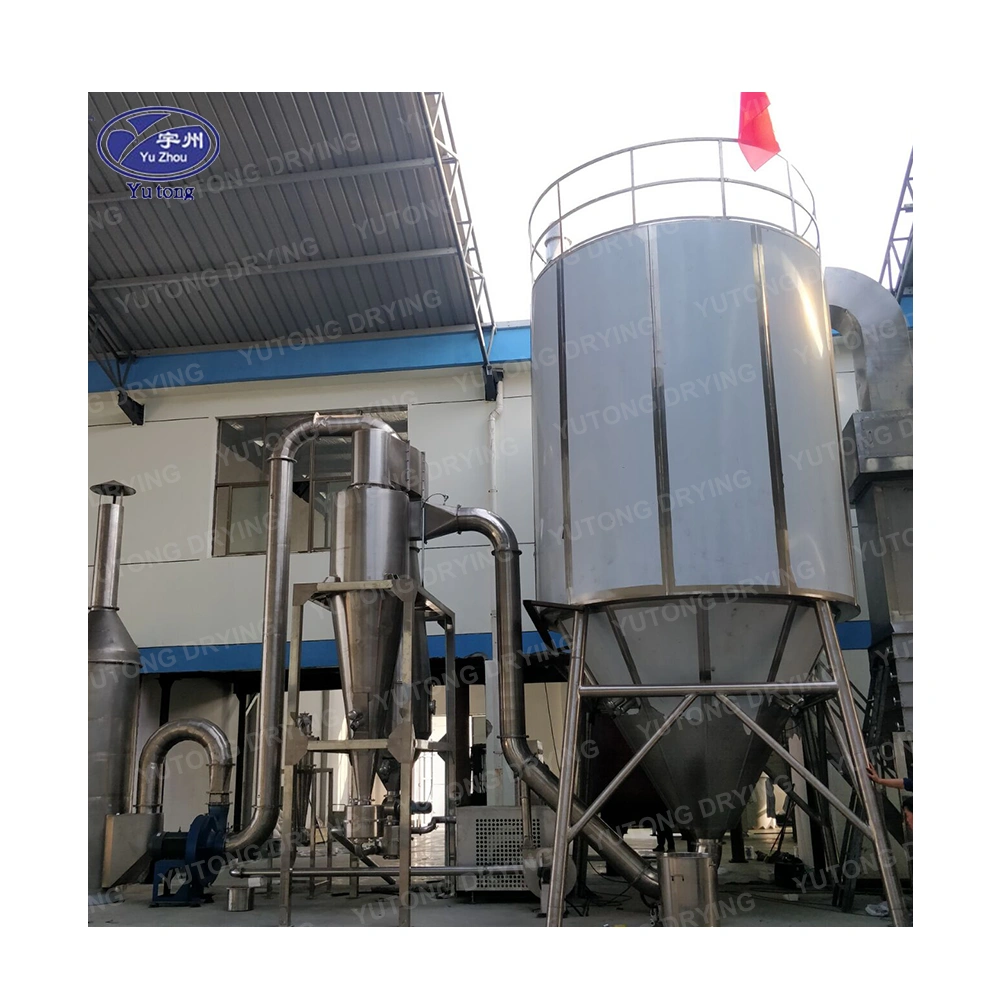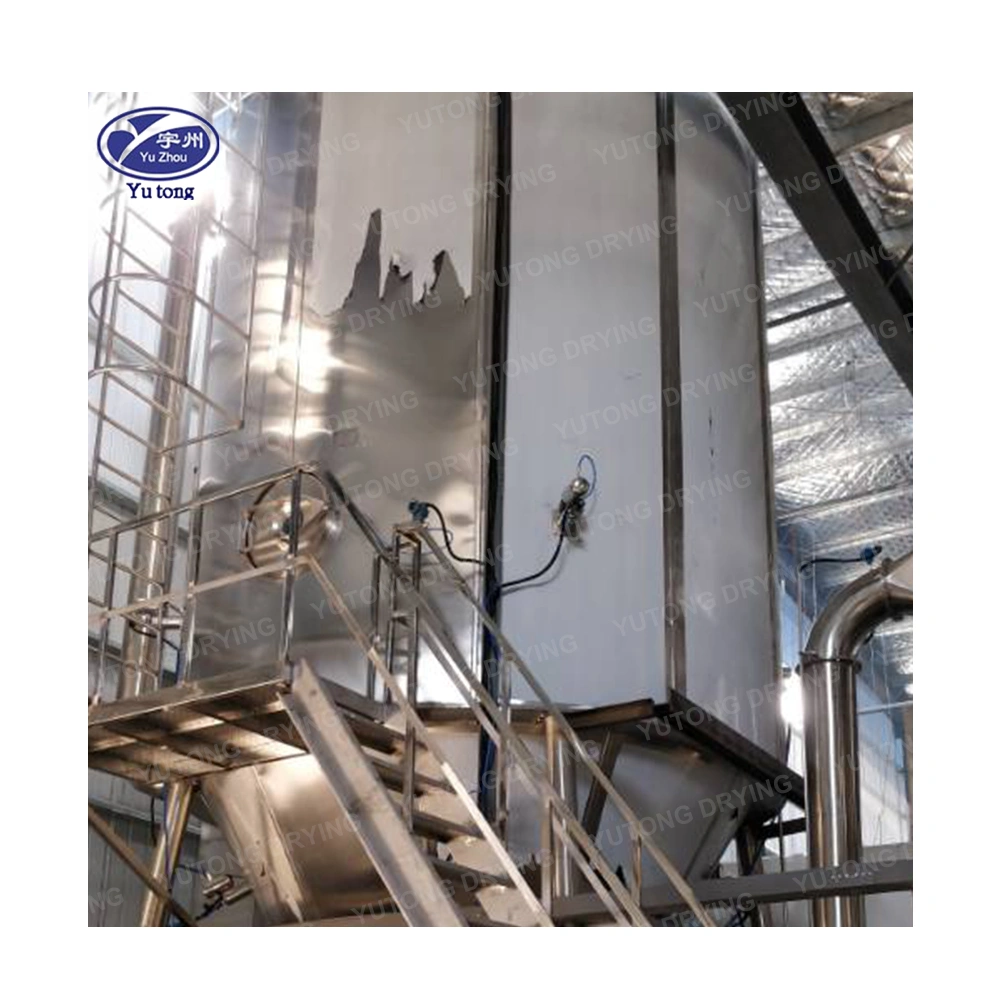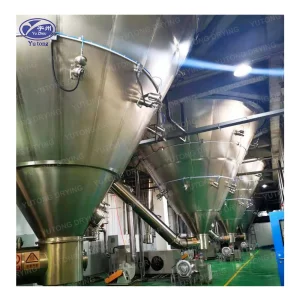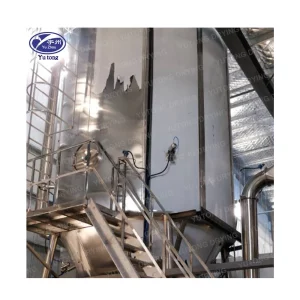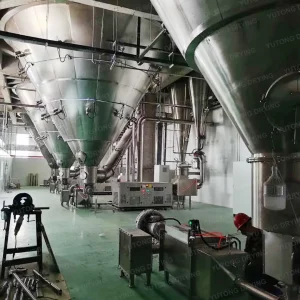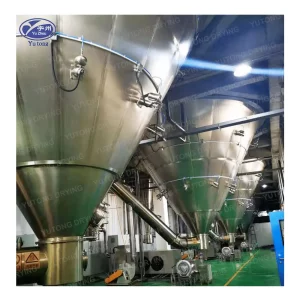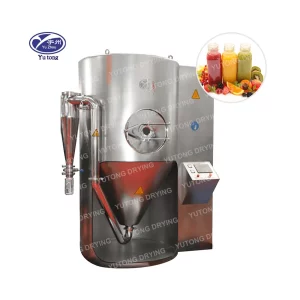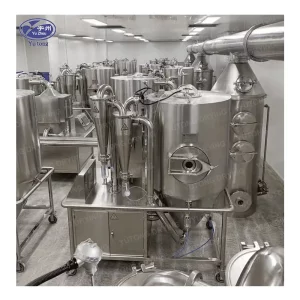Table of Contents
Product Detail
Basic Principle:High-speed centrifuge atomizing for theextract of traditional Chinese medicineis an application of centrifuge atomizingtechnique. lt also uses high-speed atomizerto make liquid material into foggy dropletto contact with hot air fully to finish instantdrying and get final powder product.
Main Features1) The tower body is equipped with cool air jacket to reduce inside tower temperature and eliminate product preheating and soften phenomenon
2) The atomizer on top of tower is equipped with cooling device to reduce atomizer temperature, at the sameeffectively eliminate material return to the top in eddy current and avoid preheat coking phenomenon3) Tower body and pipeline is equipped with manual quick-open cleaning hole and drainage hole. ClP automaticcleaning device can also equipped if needed.
4) A automatic control constant temperature feeding tank can be equipped
5) Manual high pressure washing tools can be offered as accessories together with spray dryer.6) All product contact parts are made with Stainless Steel, (or whole parts with stainless steel)7)Product collect way adopts two grade cyclones and water film duster.
8) Air inlet temperature is automatic and continuous control which is interlocked with feeding9)An air sweeping device can be optional for some products
aspen spray dryer
When it comes to drying processes in the chemical and pharmaceutical industries, spray drying is a crucial method. It transforms liquid substances into powder form by rapidly drying with a hot gas. This article explores the Aspen Spray Dryer, its significance, and how to model a vacuum dryer in Aspen Plus—a powerful process simulation software.
Understanding Spray Drying
Spray drying is a method in which a liquid is converted into a dry powder by atomizing it into a hot drying medium. This process is essential for producing high-quality powders from solutions or slurries. The result is a free-flowing powder with specific particle size, moisture content, and bulk density.
The Science Behind Spray Drying
Spray drying involves several complex physical and chemical processes. The liquid feed is atomized to create tiny droplets, which are then exposed to a hot drying medium. As the droplets move through the drying chamber, they lose moisture rapidly. The temperature difference between the droplet surface and the drying gas drives this moisture removal.
Factors such as droplet size, drying temperature, and air flow rates influence the process. Understanding these variables is essential for controlling the drying rate and ensuring product quality. The droplet’s temperature, air velocity, and humidity levels are critical parameters that must be optimized for efficient drying.
Historical Context and Evolution
Spray drying technology has evolved significantly since its inception. Initially developed for the dairy industry, it has expanded into the pharmaceutical, chemical, and food industries. Technological advancements in spray drying have led to improvements in energy efficiency, product quality, and operational flexibility.
Over the years, innovations such as nozzle design, drying chamber configurations, and heat recovery systems have enhanced the process. These advancements have enabled the production of a wide range of products with varying characteristics. The continual development in this field has been driven by a need for more sustainable and cost-effective drying methods.
Modern Applications and Innovations
In modern industries, spray drying is used to produce powdered forms of products with precise specifications. It is widely utilized in creating instant coffee, powdered milk, detergents, and pharmaceutical excipients. Recent innovations include the development of spray-drying techniques for heat-sensitive materials and nutraceuticals.
Emerging technologies such as nano spray drying and encapsulation are expanding the application scope. These advancements are paving the way for more specialized applications, including biotechnology and advanced materials. As industries continue to demand higher quality and efficiency, spray drying technology will undoubtedly continue to evolve.
Components of a Spray Dryer
A typical spray dryer consists of:
- Atomizer: Converts the liquid into fine droplets. The atomizer is the heart of the spray drying system, determining the droplet size and distribution. Different types of atomizers, such as rotary and nozzle atomizers, are used based on the product requirements.
- Drying Chamber: This is where the droplets come into contact with the hot gas. The design of the drying chamber impacts the residence time and heat transfer efficiency. It must be carefully designed to prevent agglomeration and ensure uniform drying.
- Cyclone Separator: Separates the dried particles from the exhaust air. The cyclone separator is crucial for recovering the dried powder and minimizing product loss. Its efficiency is determined by the particle size and the cyclone’s design parameters.
- Collector: Collects the final powdered product. The collector system must be designed to handle the powder gently to avoid degradation. It can include bag filters or electrostatic precipitators for fine particle collection.
Benefits of Spray Drying
Spray drying offers numerous benefits, such as:
- Producing uniform particle sizes. Consistent particle size is critical for product performance and quality. It affects the dissolution rate, texture, and appearance of the final product.
- Controlling moisture content. Moisture control is essential for product stability and shelf life. Spray drying allows precise control over the final moisture content, which is vital for preventing microbial growth and spoilage.
- Enhancing the stability and shelf-life of products. By reducing moisture content, spray drying helps in improving the product’s stability. It also protects sensitive ingredients from degradation due to oxidation or hydrolysis.
Aspen Plus and Spray Drying
Aspen Plus is a process modeling tool widely used in chemical engineering. It allows engineers to simulate processes, optimize designs, and predict performance. Modeling a spray dryer in Aspen Plus involves setting up the process using its built-in unit operations and thermodynamic models.
Introduction to Aspen Plus
Aspen Plus is a comprehensive process modeling environment used extensively across industries. It offers a wide range of modeling capabilities for designing and optimizing chemical processes. With its advanced simulation tools, engineers can predict the behavior of complex systems and make informed decisions.
The software provides a library of unit operations, thermodynamic models, and physical property databases. These features enable the accurate modeling of processes such as spray drying, distillation, and crystallization. Aspen Plus is a valuable tool for both research and industrial applications.
Steps to Model a Spray Dryer in Aspen Plus
- Define the Process Flow: Create a flow diagram that includes all relevant equipment and streams. This step involves identifying all inputs, outputs, and intermediate stages in the process. A well-defined process flow is crucial for accurate simulation results.
- Input Material Properties: Enter the physical and chemical properties of the feed material. The accuracy of these properties directly impacts the simulation’s reliability. It is essential to use precise data for phase behavior, heat capacity, and other critical properties.
- Select Unit Operations: Choose the spray dryer unit operation from Aspen’s library. The selection of appropriate unit operations is vital for modeling the spray drying process accurately. Aspen Plus offers various configurations to suit different drying requirements.
- Configure Operating Conditions: Set parameters like inlet temperature, pressure, and flow rates. These conditions must be optimized to ensure efficient drying and product quality. Understanding the interactions between these variables is key to successful modeling.
- Run the Simulation: Execute the model to analyze the drying process. Running the simulation allows engineers to evaluate the process performance and identify potential improvements. It provides insights into energy consumption, product yield, and operational efficiency.
Key Considerations in Modeling
- Thermodynamic Data: Accurate data is crucial for precise simulation results. The selection of appropriate thermodynamic models influences the accuracy of phase equilibria and heat transfer predictions.
- Droplet Size Distribution: Impacts the drying rate and final product quality. The droplet size distribution affects the surface area available for heat and mass transfer. It is a critical parameter for optimizing the drying process.
- Heat and Mass Transfer: Must be accurately modeled for reliable predictions. Understanding the mechanisms of heat and mass transfer is essential for simulating the drying behavior accurately. It involves complex interactions between the drying medium and the droplets.
Modeling a Vacuum Dryer in Aspen
A vacuum dryer operates under reduced pressure, which lowers the liquid’s boiling point. This is beneficial for drying heat-sensitive materials. Modeling a vacuum dryer in Aspen Plus requires careful attention to pressure settings and material behavior under vacuum conditions.
How Vacuum Drying Works
Vacuum drying is a technique for drying materials at lower temperatures. By reducing the ambient pressure, the liquid’s boiling point is lowered, allowing for gentle drying. This is particularly beneficial for preserving the integrity of heat-sensitive substances.
The process involves creating a vacuum within the drying chamber, which facilitates moisture removal. The reduced pressure environment accelerates the drying process while minimizing thermal degradation. Vacuum drying is commonly used for pharmaceuticals, food products, and specialty chemicals.
Steps to Model a Vacuum Dryer
- Select Appropriate Modules: Use Aspen’s vacuum drying modules or customize a dryer model. The choice of the module depends on the specific drying requirements and material properties. Aspen Plus offers flexibility in configuring custom models for unique applications.
- Set Vacuum Conditions: Adjust pressure settings to simulate vacuum conditions. Accurate pressure control is essential for achieving the desired drying rate and product quality. It requires precise calibration of the vacuum system and continuous monitoring.
- Input Material Data: Ensure data reflects the behavior of materials at low pressures. Material properties such as vapor pressure, heat capacity, and thermal conductivity must be accurately defined. These properties influence the drying kinetics and energy requirements.
- Analyze Results: Evaluate the drying time, energy consumption, and product quality. Simulation results provide insights into process efficiency and potential areas for improvement. It allows engineers to optimize the drying conditions and minimize energy usage.
Challenges in Vacuum Dryer Modeling
- Pressure Control: Maintaining stable vacuum levels can be challenging. Fluctuations in pressure can affect the drying rate and product consistency. It requires precise control systems and regular maintenance to ensure stability.
- Material Properties: Variations in material behavior under vacuum need careful consideration. Different materials respond differently to vacuum conditions, impacting drying efficiency. It necessitates a thorough understanding and accurate characterization of material properties.
Practical Applications
Spray dryers and vacuum dryers are used across various industries, including:
- Pharmaceuticals: For producing active pharmaceutical ingredients (APIs). Spray drying enhances the solubility and bioavailability of poorly soluble drugs, improving therapeutic efficacy.
- Food Industry: In the production of milk powder, coffee, and spices. Vacuum drying preserves heat-sensitive nutrients and flavors, maintaining product quality and nutritional value.
- Chemicals: For creating fine powders and granules. The precision of spray drying allows for the production of uniform and high-quality chemical products.
Industry Examples
- Pharmaceuticals: Spray drying is used to enhance the solubility and bioavailability of drugs. It allows for the production of amorphous solid dispersions, improving drug delivery and absorption rates.
- Food Processing: Vacuum drying is applied to preserve heat-sensitive nutrients and flavors. It is used for dehydrating fruits, vegetables, and herbs while retaining their natural color and taste.
- Chemical Manufacturing: Spray drying creates consistent particle sizes and improves product stability. It is employed in the production of catalysts, pigments, and detergents for various applications.
Conclusion
Understanding the intricacies of spray drying and vacuum drying is vital for industries reliant on powder production. Using Aspen Plus to model these processes allows for optimization and efficiency improvements. By accurately simulating spray dryers and vacuum dryers, engineers can design better processes, reduce costs, and enhance product quality.
Incorporating these techniques into your workflow can lead to significant advancements in product development and manufacturing efficiency. Whether you’re in pharmaceuticals, food, or chemical manufacturing, mastering Aspen Plus and its capabilities will undoubtedly prove beneficial.
Remember, the key to successful modeling lies in detailed input data, careful configuration, and thorough analysis. Happy modeling!
Specifications
|
spec
|
ZPG-25
|
ZPG-50
|
ZPG-80
|
ZPG-100
|
ZPG-150
|
ZPG-200
|
ZPG-300
|
|
|
evaporation capacity(kg/h)
|
25
|
50
|
80
|
100
|
150
|
200
|
300
|
|
|
process amount of material liquid(kg/h)
|
25-34
|
50-68
|
80-108
|
100-135
|
150-203
|
200-270
|
300-406
|
|
|
output of finished pcoduct(kg/h)
|
4.8-7.2
|
9.2-14
|
14.8-22.4
|
18.4-28
|
24-42
|
36.8-56.4
|
55-85
|
|
|
solid content of material liquid( %)
|
18-30
|
|||||||
|
moisture content of finished product( %)
|
3-5
|
|||||||
|
electric power(kw)
|
63
|
132
|
153
|
204
|
246
|
330
|
||
|
heat source
|
Steam pius electricity
|
|||||||
|
Collecting method of product and its efficiency
|
Grade one or two or three stage cyclone wet dust remover is greater than or equal to 95%
|
|||||||
|
automatic control meters and instruments
|
indicator of not air and exhaust air temperature
|
|||||||
|
temperature of air inlet(℃)
|
160-220
|
|||||||
|
temperature of air outlet(℃)
|
80-100
|
|||||||
|
L
|
7000
|
8000
|
9800
|
11000
|
12200
|
14100
|
15000
|
|
|
overal dimensions(mm)
|
W
|
4000
|
5000
|
5700
|
6200
|
7000
|
7800
|
9000
|
|
H
|
6200
|
6900
|
8000
|
8900
|
10750
|
11900
|
13000
|
|
Applications
Applicable Industries: Building Material Shops, Manufacturing Plant, Machinery Repair Shops, Food & Beverage Factory, Farms, Restaurant, Retail, Food & Beverage Shops

